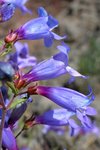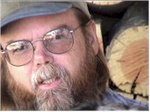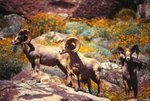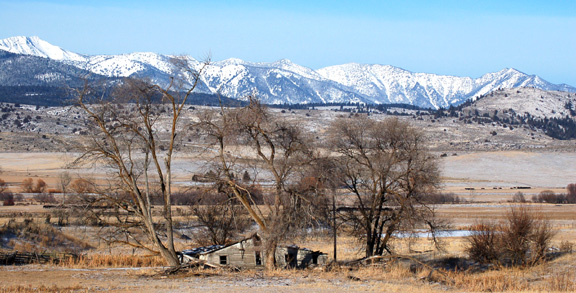- A PERSONAL NOTE
- ENVIRONMENT
- Sage Grouse
- Grazing Fee
- The Great Backyard Bird Count
- The Unwelcome Guest, Woody Guthrie, sung by Wilco( again)
__________________________
A PERSONAL NOTE
My neighbor, Frank, is one of the nicest people I know in Baker City. I think it is fair to describe Frank as a "Country Boy," man in this case, who knows the wilds of Baker County probably as well as any, because he grew up in Keating, hunts game across the county, and has spent enormous amounts of time in the woods doing various things, including maintaining fence yearly for a local rancher. That rancher has a Forest Service grazing allotment on the Wallowa-Whitman National Forest in the Catherine Creek area, which contains both threatened steelhead and bull trout, not to mention spring chinook. Frank has been a good person to talk to about Baker City politics because he knows the people and the history, and sees the place of his roots worth caring about. He looks after my place when he knows I'm not around, and I do the same for him. One of his close relatives is a photographer, as I am, with interests in the natural world.
I am really a city boy who rejected that life early on for the country, where the roots of my Montana born father dug in. My grandfather was a sheepherder in his youth, had his own dairy and egg ranch in later life in Pasadena, CA, and returned to Montana to try a small cattle ranch there at the age of 70. Other relatives had made a living off raising cattle and/or sheep or dairying in Montana too. The big but though, which most of my Montana relatives wouldn't care for, is that I am an "environmentalist," among other things, in a county and region that doesn't much care for environmentalists or some of the other views I hold. More specifically, I have worked on a legal grazing case involving threatened or sensitive fish on the Malheur National Forest for almost a decade, with my involvement on the Malheur going back to 1999. Before that I have attempted to get the BLM and Forest Service to better protect the land from grazing pressures in both Utah and California since the 1980's. Due to my biology background, reading, and my walking the streams, springs, and uplands of the American West, in my own way, I know something about grazing too. Unfortunately, I don't always see the land the same way the people that grew up in the rural West do.
It is an interesting situation. Two humans from two different cultures, living side by side, with their own, and sometimes quite different experinces in, and views of this world. While I haven't talked about it much, for obious reasons, I know the ranchers, some of the local lawyers, and people like my neighbor Frank, know about my past environmental work, and what I value. A culture and values clash that takes a certain toll on the humans involved (especially if you are in the extreme minority), with none really knowing how to bridge the divide, but with at least some, still seeking to be civil and decent--like my neighbor Frank.
One problem for me, and a lot of people who are forced in one way or another to interact with me, is that I place a high value on being to express myself, to present views that run against the current of popular opinion, and to try to stay true to my own light and principles. That is one reason I write this blog and hope to be able to continue doing so for a while, even if what I write may offend the views and interests of a majority of citizens. I like to pretend that America was supposed to be all about individuals expressing opinions even when they might be unpopular and challenge conventional wisdom and power. Sometimes it seems like we need a lot more of it.
In that vein, this particular blog, along with many of the previous, will present some more unpopular opinions. I hope that others will still say "hi" on occasion and remember I am also human, but because of a long history of questioning the "conventional wisdom" and traditional practice with regard to many issues, and having felt many a chill social wind for my views and actions over what is starting to become a long lifetime, I am prepared for any eventuality. That is because the only two answers to the question of "If you can't be your self, who can you be?" is either "Somebody else" or "nobody" at all.
Chris
_____
ENVIRONMENTAL ISSUES
- Sage Grouse
A January 28, 2010 Editorial by the Baker City Herald stated that (my comments are in brackets []):
"The results of a scientific study released a couple weeks ago suggest that on the ornithological intelligence scale, sage grouse are closer to the dodo bird than to the parrot." . . . . "This study would have really tickled us, except that it could inform a decision that would have a dramatic, and detrimental, effect on ranchers in Eastern Oregon and across much of the West."
[Hmmmm.
Up to this point they have not given us any information about the results of the study, but it is clear that they are leading you to a conclusion: Sage Grouse are really stupid, and perhaps deserve the same fate as the extinct dodo bird, a big flightless island bound bird, who knew no native predators, that was mercilessly slaughtered by humans, by the animals they introduced, and whose survival was further imperiled by human alteration of their habitat, on the Island of Mauritius. The last of them were lost to the world forever between 1688 and 1715.
The connection between the decline of the dodo bird and the decline of the sage grouse, isn't about their intelligence, it's about ours. Some of our species thoughtlessly destroyed them for private gain, and we have done the same to the sage grouse.
Here is some information from the Environmental Defense Fund about the study, and a similar 2004 study concerning lesser prairie-chickens fence mortalities:
"Several studies have shown wire fencing to be a main cause of mortality for sage-grouse and lesser prairie chickens because they can’t see the thin wires and fly into them. In the results of an ongoing study released late in October 2009, during a 31-month period, the Wyoming Game and Fish Department documented 146 instances of finding sage-grouse feathers or carcasses on or near a 4.7-mile section of barbed-wire fence near Farson in western Wyoming. Subsequent research concluded that colored tags helped sage-grouse avoid flying into the fence. Fence collisions were attributed to more than 33 percent of lesser prairie-chicken mortalities in a 2004 Oklahoma/New Mexico study.
The BLM’s directive to its western field offices are similar to recommendations Environmental Defense Fund made in a January report."
See also: Report: Barbed wire fences deadly to sage grouse
Before we get to far along, it must be clearly stated that fences or no fences, livestock grazing negatively affects sage grouse populations, and the fact is well documented in the literature. Here is a summary from WildEarth Guardians, "Western Wildlife Under Hoof, p. 10":
Sage-grouse and sagebrush habitat are negatively affected by domestic livestock grazing. In spring, the breeding season, livestock eat and trample the grasses and forbs around sagebrush, which can degrade or eliminate nesting and brooding habitat. Nests that are exposed to the wind, sun and predators are less productive than nests in healthy sagebrush-steppe. Without the forbs and grasses, insects are also less abundant, reducing an important food source for sage-grouse chicks.
In the hot summer, thirsty livestock often severely overgraze riparian areas and mesic sites (wet meadows) that are important to sage-grouse young and adults. Livestock also eat and trample sagebrush, the only food source available to sage-grouse in winter. Wandering livestock can stress sage-grouse and other wildlife, and their grazing opens the vegetative cover, exposing sage-grouse to predators and the weather. In one case researchers observed a cow eating a sage-grouse egg from a
nest!
And from my Great Basin Grazing Album on Rangenet:
 Just click here to read about the link between sage brush, cows, sage grouse, cheatgrass and fire.
Just click here to read about the link between sage brush, cows, sage grouse, cheatgrass and fire.So, the Herald continues]:
"The feds’ decision is significant. If the chicken-size bird is given federal protection, then some ranchers could be forced to stop grazing cattle on public lands that biologists deem critical habitat for sage grouse."
[OK, so in the event they are protected, public land managers have a choice, they can save a local, nationally treasured and milleniums old species, the sage grouse, or save the special economic privilege of a few public lands ranchers, who have been making a living by degrading publicly owned sage grouse habitat. On the national level it is a no-brainer.]
The Herald continues:
"Biologists from the U.S. Fish and Wildlife Service and other agencies have laid most of the blame for the decline in sage grouse populations on the conversion of sagebrush habitat to such things as housing and agriculture."
[No mention by The Herald that agriculture includes a lot of cows and the conversion of sage brush communities to grazing land. The Oregon Division of fish and Wildlife is no particular friend of environmental interests as they serve their agricultural and hunting group masters. None-the-less, they remind us of the following in their GREATER SAGE-GROUSE CONSERVATION ASSESSMENT:
Sagebrush Conversion
Prior to the 1980s, herbicide treatment of large tracts of land (primarily using 2,4-D) was a common method of reducing sagebrush (Braun 1987). In addition to the loss of sagebrush the use of 2,4-D resulted in the decline of forbs (Miller and Eddelman 2001). In many cases, broad herbicide treatment may have contributed to declines in sage-grouse breeding populations (Enyeart 1956, Higby 1969, Peterson 1970, Wallestad 1975). A Utah study suggests this adverse impact on sage-grouse was compounded if the area was subsequently reseeded to crested wheatgrass (Agropyron cristatum) (Enyeart 1956). In Malheur County, for example, the Vale Project resulted in approximately 202,000 ha (500,000 ac) of sagebrush eradication projects for the benefit of livestock grazing (Willis et al. 1993). Approximately 50% of the treated area was reseeded with crested wheatgrass. Most of these treatments occurred on mild slopes in areas of deep soil which, based on current knowledge of sage-grouse, impacted breeding and winter habitats. (pp 28 & 40)
The Federal Register / Vol. 69, No. 77 / Wednesday, April 21, 2004 / Proposed Rules, also states, to quote a case between Western Watersheds Project and the US Forest Service (Case No. CV-06-277-E-BLW):
The FWS identified a number of causes for this habitat loss, including (1) agriculture (“millions of hectares of native sagebrush habitat have been cultivated for [agricultural] production”), (2) herbicides (“[c]hemical control of sagebrush has resulted in major declines of sage-grouse breeding populations through the loss of sagebrush cover”), (3) grazing (“grazing by livestock could reduce breeding habitat”), (4) fire (“[w]ildfires have destroyed extensive areas of sagebrush habitat in recent years,” and these fires allowed invasion of cheatgrass, “an exotic species that is unsuitable as sage-grouse habitat”), and (5) development (“sage-grouse habitats also are fragmented by fences, powerlines, roads and other facilities associated with grazing, energy development, urban/suburban development [etc.] . . . .”). IFederal Register / Vol. 69, No. 77 / Wednesday, April 21, 2004 / Proposed Rules at 21488-90.
So while the F&WS lays the blame on their 5 reasons, the first of which is agriculture, the second of which is herbicide use, that in reality involved many thousands of acres converted for grazing use, and the third of which was laid directly at grazing's feet, the word grazing, in reference to "blame for the decline in sage grouse populations," is missing from the Herald editorial. Again, hmmmmmm.
Th Herald tries to tie it all together by reporting on a Wyoming study which documented amazing numbers of sage grouse dying after trying to negotiate one "4.7-mile section of barbed-wire fence."
They end with the following [my comments interspersed - Chris]:
Herald: ""We have no reason to question those statistics.
What worries us, though, is the prospect of federal officials citing the Wyoming study as evidence that sage grouse need the powerful protection of the Endangered Species Act".
[The F&Ws will be weighing many variables, not just grouse collisions with barbed-wire, in making their determination on whether listing is warranted. All they can logically conclude is that barbed-wire fence is one cause of sage grouse mortality and that the hundreds of thousands of miles of these barbed-wire fences are in publicly owned sage grouse habitat in order to control cattle grazing. Overall population size and trend, as well as regional population and trend data, and other factors will be used to make the determination. What worries me, is that in the Bush administration, politics too often trumped science in making these decisions, and that the Obama administration may allow the practice to continue. - Chris]
Herald: "The source of our skepticism is this: Barbed-wire fences have been widespread in the West for close to a century, yet even experts from the Western Association of Fish and Wildlife Agencies wrote in an assessment that sage grouse populations have been relatively stable since dropping substantially from about 1960 through the mid-1980s."
[Here is a quote from the report cited:
"Our results generally suggest a long-term decline in greater sage-grouse maximum male counts with the greatest declines from the mid-1960s to the mid-1980s. The range-wide analysis showed quadratic, declining trends for the 1965-2007 and 1965-1985 timeframes. The quadratic trend was less certain for the 1986-2007 time period when male counts seemed to decline early in the time period and then slightly increase in the later period after 2000 (Emphasis Added) ."
What this says is that the overall trend is down, with a mixed and uncertain trend between the years 2000 and 2007, with a slight increase toward the end of the timeframe. It most certainly does not say "sage grouse populations have been relatively stable since" the mid 80's, but there are some reasonable explanations for the change in trend. The larger context, unmentioned, is that "Greater sage-grouse distribution has decreased by 56 percent while rangewide abundance has declined by as much as 93 percent from historic levels." For our region, the prognosis for sage grouse is not good: "The greater sage-grouse population of eastern Oregon is the lowest it has been in nearly 15 years, signaling bad news for the arid sagebrush country of the Northwest, according to new (2009) research from Seattle-based think tank Sightline Institute."]
Herald: "The obvious question, then, is why, if barbed-wire fences are such deadly obstacles for sage grouse, the birds have managed to not only survive, but for periods thrive, in a region where tens of thousands of miles of such fence have been in place for many decades?
Perhaps the federal government’s bird experts can answer that question.
If they cite barbed-wire fences as justification for listing sage grouse, we hope that answer is backed with convincing evidence."
[The Herald, and anyone else who wants to take the time to comment on a proposal to list the sage grouse will have the opportunity to do so at the appropriate time, and either side of the question, may take the opportunity to disagree. The denial or approval to list the sage grouse is not going to be based on a single variable, such as how many birds get strung-up on barbed-wire fencing, even though it is clear that the hundreds of thousands of miles of these fences associated with livestock grazing on our public lands are a significant cause of sage grouse and other wildlife mortality, including deer, pronghorn and other bird species like owls.]
How Many "Dodo" Birds and Mammals Are There?
 Short-eared Owl Mortality Photographed in the Baker Valley Last Month. Its Wing Got Hooked On A Single Barb.
Short-eared Owl Mortality Photographed in the Baker Valley Last Month. Its Wing Got Hooked On A Single Barb.Many flying animal species, including ducks, meadowlarks, and bats find a similar fate, as do ungulates like pronghorn and deer.
But I digress--Back to the question of why has the trend for the decline in sage grouse numbers eased a bit?
It would be logical to suggest the the earlier serious decline between in the years 1965-1985 have been in part due to increases in barbed-wire fencing miles on the public lands. Jon Marvel, of Western Watersheds Project, estimates that over half of the fencing on public grazing lands has been installed since 1960. (Private communication) Larry Walker, a 30+ year BLM employee, and moderator of RangeNet, says in another private communication:
"BLM has "Public Land Statistics" online for about the last decade that includes miles of new fence in table 2-3. A quick check of some of the figures indicate construction of new fences at the rate of 300 to 600 miles per year in the 1990's."
So a logical explanation for at least some of the decreasing trend in sage grouse populations is that barbed-wire fencing has been increasing for decades. But what about the post 2000 change in trend?
In 1994, the BLM and Forest Service began reforming grazing practices on public lands. While it did not go nearly far enough, they did finally institute some reform of rangeland management with the western states instituting new standards for ranchers to aspire to. Significantly, in the 1990's, the BLM began to foster a new ethic of restoration, feeble as it may have been, to restore riparian areas and sage brush habitat in many areas of the west. This effort, along with continuing reductions in livestock AUMs (numbers of cow and calf pairs) allowed to graze the public lands, including our sage grouse habitat, may have altered the downward trend slightly. But barbed-wire is barbed-wire, so the more of it that goes in, and the more grazing that goes on, in sage grouse habitat, the more sage grouse numbers will continue to be depressed.
Where I hope the Herald and I agree is that the threats to sage grouse are more complicated than a barbed-wire fence.
_____
Related News--Idaho Conservation Agreement:
Sent: Friday, February 12, 2010 2:05 PM
Subject: IDFG news release
IDFG News Release today:
Sage-grouse Conservation Agreement Signed
Officials with the Idaho Department of Fish and Game, the U.S. Fish and Wildlife Service, and the Natural Resources Conservation Service on Friday, February 12, signed a landmark conservation agreement to protect sage-grouse in west-central Idaho.
The Candidate Conservation Agreement with Assurances will be the first such agreement for greater sage-grouse anywhere in the bird's range. Under this agreement, private property owners in the area covered by the agreement who adopt voluntary conservation measures would receive assurances that they would not be subject to increased regulations should sage-grouse be listed under the Endangered Species Act.
"We hope agreements like this could be a model for future sage-grouse conservation efforts in Idaho and throughout the West," Idaho Fish and Game Director Cal Groen said. "We're proud to be part of this pioneering effort to work with private land owners to protect sage-grouse."
Sage-grouse have become a symbol of healthy sagebrush ecosystems across the West. Once plentiful, their numbers have declined for a variety of reasons. Invasions of exotic annual grasses have modified fire regimes, conversion of sagebrush stands to agricultural use, energy development, subdivision of rural lands and other human developments have fragmented and reduced the large, secure expanses of habitat necessary to sustain sage-grouse.
The well-documented declines in the number of sage-grouse and the reasons for those declines have led to consideration of greater sage-grouse for listing as "threatened" or "endangered" under the Federal Endangered Species Act.
In response to a potential listing and the associated potential effect to property owners, Idaho, in coordination with the West Central Sage-grouse Local Working Group, has developed this programmatic Candidate Conservation Agreement with Assurances. The local working group consists of local private landowners, agencies and other parties interested in sage-grouse. The U.S. Fish and Wildlife Service and the Natural Resources Conservation Service are helping with funding and implementation on private lands.
"This is species conservation at its best, and the efforts will help conserve greater sage-grouse and their habitat, while ensuring landowners have the flexibility to maintain operation on their lands," said Jeff Foss, U.S. Fish and Wildlife Service's Idaho state supervisor.
This 30-year agreement would facilitate conservation of sage-grouse and their habitat in portions of Adams, Gem, Payette and Washington counties. More than 644,000 acres could be considered for enrollment in the agreement. Landowners who sign up, would not be burdened with additional regulations as long as they meet the terms of the agreement, should sage-grouse be listed.
Landowners may be eligible for federal Farm Bill programs administered by the Natural Resources Conservation Service to help offset costs of conservation work.
"We are excited about the opportunity to offer our various Farm Bill programs to enrolled landowners within the West Central area to help restore and enhance sage grouse habitat on their working farms and ranches," said Jeff Burwell, NRCS state conservationist.
Idaho Fish and Game will have the primary responsibility to work with private landowners who sign up under the agreement to develop individual plans for sage-grouse conservation on their lands.
"This agreement again demonstrates the state of Idaho's commitment to collaborative conservation," said Tom C. Perry, acting administrator of the Governor's Office of Species Conservation. "Only through collective and collaborative efforts, such as the Candidate Conservation Agreement with Assurances, can the state and its partners conserve this important species and its habitat while providing a measure of certainty and predictability for landowners."
Greater sage-grouse are under consideration for protection under the Endangered Species Act, and a decision is expected by the end of February.
"We do not inherit the Earth from our parents; we borrow it from our children"
Antoine de Saint Exupery
David Smith
Idaho Fish & Game
Wildlife Bureau
______________________
- Grazing Fee
Brief History:
As you probably know, if you are from the Eastern U.S. or have travelled there, most of our public lands are in the West. A Federally owned free or low fee campsite is hard to come by east of the Mississippi River, and even in many of the western states nearby. The idea of preserving some lands for the public and the land's sake did not really take hold until the late 19th and early 20th Centuries. While those lands were initially preserved primarily for resource extraction, over the years, the majority of American citizens have come to realize the value of the natural services that the public lands provided for us, beyond what ever value the special economic interests of timber, mining, and grazing might have seen in them. This included amenities like clean water, preservation of species diversity, recreational values, "wilderness," and the unmeasured financial value of functioning ecosystems.
During the early and even more recent years after the establishment of public lands, private interests, including ranchers, were given preferential treatment, a "privilege," to use the public lands as an extension of their own private holdings in a way that allowed them to use "public lands" as if they were "private lands." Their "use" has been to the detriment of the other public stakeholders and the publicly owned ecosystems and "resources" that were present on those lands. That is, while the water, and habitat of riparian areas, and uplands were necessary for the continued reproductive success of publicly owned and appreciated species like salmon and sage grouse, cattle ranchers used the public lands without regard for those and other species, and destroyed much of the habitat necessary to the reproductive success of those species. For the most part, in the face of the continued destruction of our public lands, in particular the biologically rich riparian areas where privately owned cattle like to lounge, people are now defending the interests of those public lands and the public ecosystems that contain so many imperiled species and less "commodified" resources.
One of the reasons the ranchers, often corporations, but sometimes simple rural aristocrats, continue to decimate public ecosystems for their private use, is that their influence in Congress has returned to them the right to put a thousand pound mother cow and often a half grown calf out on those lands, to chew up all of the available protective cover, in the form of vegetation needed by other publicly sponsored native species, at the cost of a buck-35 ($1.35) a month. A grazing fee was first instituted by the Forest Service in 1906, but was not applied by the BLM, formerly the "Grazing Service," until 1936, two years after the passage of the "Taylor Grazing Act" of 1934 (43 U.S.C. 315), which was intended to regulate grazing on public lands.
According to "Cattle Grazing on Public Lands," "For the first ten years after the grazing fee was instated on BLM land, the fee was the [alleged] cost of administration of the grazing lands, five cents per Animal Unit Month (AUM)." According to this same web site, the grazing fee hit its high in 1980, when it was $2.41 for the Forest Service and $2.36 for the BLM. Obviously, it has been declining ever since. If the 1980 BLM fee had kept pace with inflation, it would be about $6.14 last year. If the Forest Service fee had kept up with inflation, it would be around $6.27 last year.
The comparison that sticks in my mind says that it costs the rancher about the same to feed the two cows your public lands vegetation and species habitat for a month as it would cost you to feed a hamster for a month. Close anyway.
So, this all brings me to a recent press release by the Center For Biological Diversity:
I.E.:
For Immediate Release, February 1, 2010
Contact: Taylor McKinnon, (928) 310-6713, tmckinnon@biologicaldiversity.org
Federal Grazing Fee Announced for 258 Million Acres: Public to Subsidize Public Land Destruction, Species Endangerment
FLAGSTAFF, Ariz.— On Friday the U.S. Forest Service and Bureau of Land Management announced that in 2010 it would not increase the paltry $1.35 monthly fee charged for each cow and calf that the livestock industry grazes on western public land. The fee remains far below what the agencies spend to administer grazing permits, it remains far below market rates, and it remains far short of providing revenue needed to correct the severe ecological damage caused by livestock grazing.
Habitat destruction caused by livestock is a primary factor contributing to the decline of threatened and endangered species including the desert tortoise, Mexican spotted owl, southwestern willow flycatcher, least Bell’s vireo, Mexican gray wolf, Oregon spotted frog, Chiricahua leopard frog, in addition to dozens of other species of imperiled mammals, fish, amphibians, and spring snails that occur on western public land. Livestock grazing is also a primary factor contributing to unnaturally severe western wildfires, watershed degradation, soil loss, and the spread of invasive plants.
“Livestock grazing destroys western public land and the habitat that species need to survive,” said Taylor McKinnon, public lands campaigns director at the Center for Biological Diversity. “The federal grazing program makes the public subsidize public-land destruction and species endangerment.”
The fees will apply to livestock grazing across 258 million acres of western public land administered by the Forest Service and Bureau of Land Management — 81 percent of the land administered by the two agencies in the 11 western states. There are approximately 23,600 public-lands ranchers, representing about 6 percent of all livestock producers west of the Mississippi River.
A 1986 executive order and 1978’s Public Rangelands Improvement Act prohibit the fee from falling below $1.35 per animal unit month, which is only $.12 more than monthly rates charged in 1966 and $.08 less than one 13-ounce can of dog food. Market rates for grazing unirrigated western private land exceed $10 per animal unit month.
“That the Obama administration continues such an antiquated, destructive, and costly use of Americans’ public lands is the exact opposite of change,” said McKinnon. “It shows that both public lands and endangered species remain near the lonely bottom of the administration’s agenda.”
A report released by the Center for Biological Diversity has detailed how the federal grazing program fails to cover its own administrative costs or those attending the environmental problems it creates. The Center for Biological Diversity and other groups have since petitioned the federal government to increase the grazing fee to account for the costs of its administration and ecological damage. The groups await a response from the government.
Remembering that "only 22% of ranchers in 11 western states use federal land," the next time I hear a public lands rancher complain about welfare or Oregon's measures 66 & 67, I'll try to remember this and the other subsidies they receive.
Rotting Cow Carcass on Public Land Grazing Allotment, Malheur National Forest, 2008.

___________________
- The Great Backyard Bird Count
Better late than never?
If you want to participate in The Great Backyard Bird Count, the instructions are included in the link.
_________________
The Unwelcome Guest, Woody Guthrie (again)
The Unwelcome Guest - Billy Bragg and Wilco











